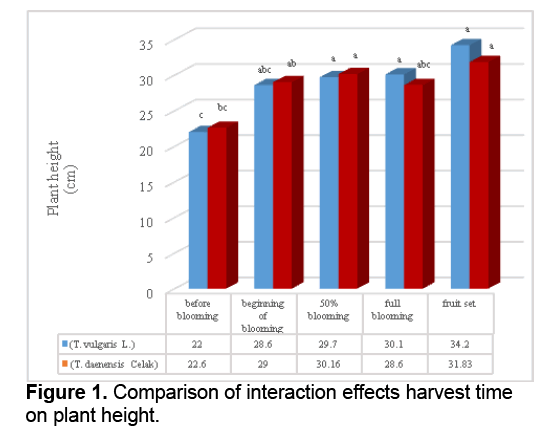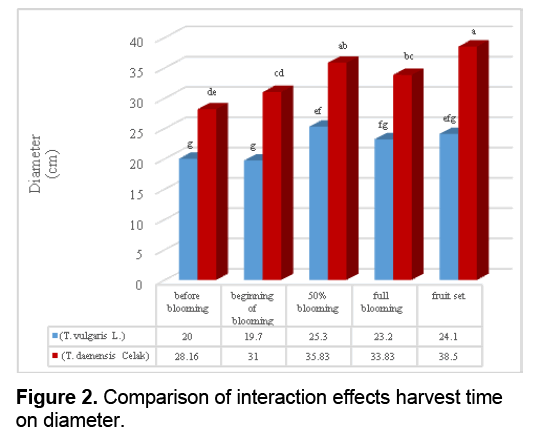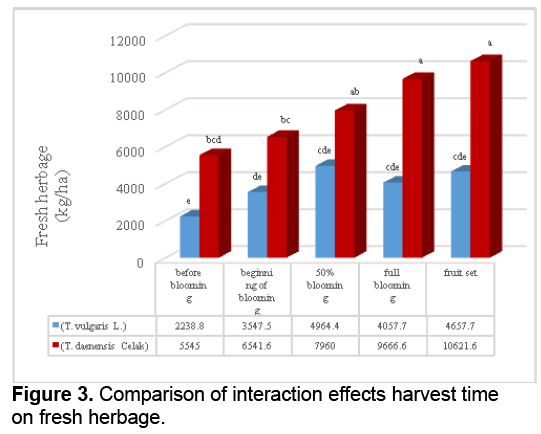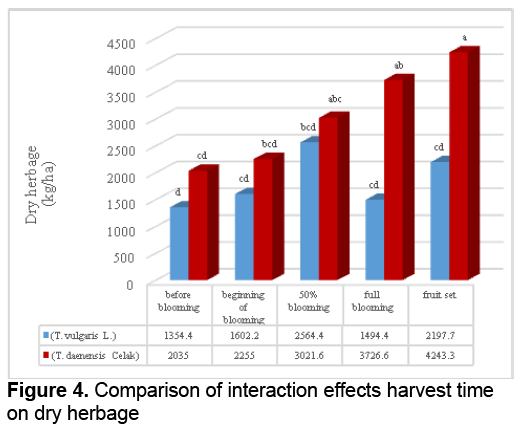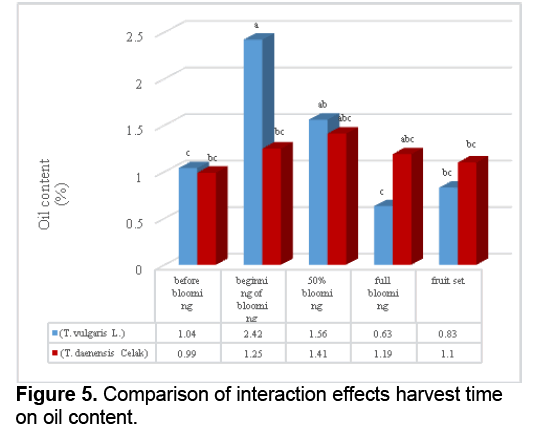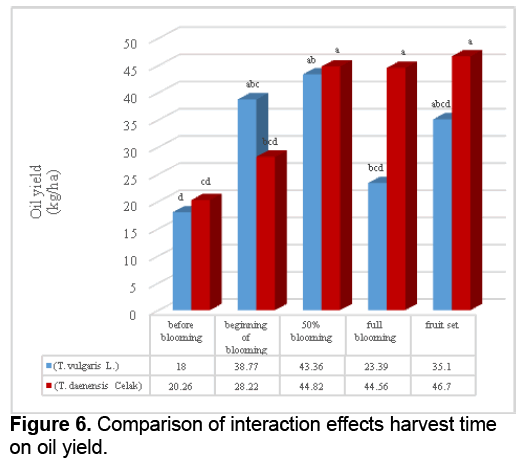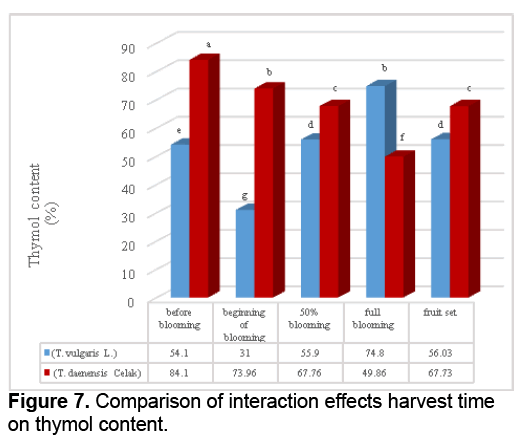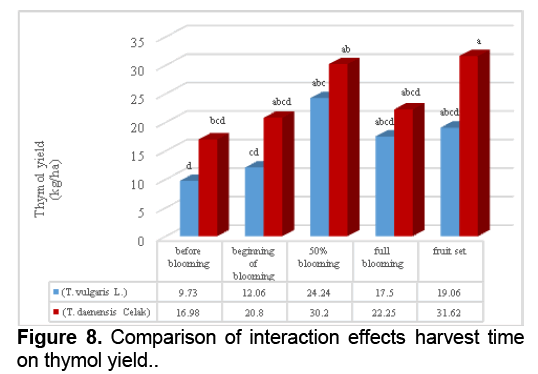Comparative Effect of Harvest Time on Essential Oil and Thymol Content of (Thymus vulgaris L.) and (Thymus daenensis Celak) in Iran Province
Ahmad Reza Golparvar, Amin Hadipanah, Saied Salehi, Hajir Beheshtizadeh
1Department of Agronomy and plant Breeding, Isfahan (Khorasgan) Branch, Islamic Azad University, Isfahan, Iran
2Department of Horticultural-Medicinal plants Science, Science and Research Tehran Branch, Islamic Azad University, Tehran, Iran
3Department of Agronomy, College of Agriculture, Sanandaj Branch, Islamic Azad University, Sanandaj, Iran
4Phd Student Of Plant Breeding, Department of Plant Breeding and Biotechnology, Faculty of Agriculture, University of Zabol, Iran.
- Corresponding Author:
- Tel: +98(0)3115354001
Fax:+98(0)3115354060
E-mail: dragolparvar@gmail.com
Abstract
Thymus vulgaris L. and Thymus daenensis Celak from mint family (Lamiacae) traditionally being used as source of the essential oil and phenolic components derived from their different parts. In order to optimum of harvest time this experiment has been conducted in field Islamic Azad University, Isfahan (Khorasgan) branch, in center Iran during 2012 farming season on the base of factorial experiment in the layout randomized complete block design with three replications. The aerial parts of T. daenensis and T. vulgaris were collected in five stages of plant growth, i.e. the before blooming, beginning of blooming, 50% blooming, full blooming and fruit set. The hydro-distillated oils obtained from thyme species were analyzed by GC–MS. Statistical analysis indicated that different stages of plant growth had significant effect on plant height, diameter, dry herbage, oil yield, thymol percentage and thymol yield of thyme species. Results of mean comparisons revealed that the highest fresh herbage (7639.72 kg) and the highest dry herbage (3220.55 kg) were obtained at the stage of fruit set. The highest oil content (1.62 % v/w) was obtained at the stage of beginning of blooming and the highest thymol content (69.1%) was obtained at the stage of before blooming. Comparison of interaction effects harvest time on oil content revealed that the highest oil content T. daenensis (1.41 %) was obtained at the stage of 50% blooming and the highest oil content T. vulgaris (2.42 %) was obtained at the stage of beginning of blooming and the highest thymol content T. daenensis (84.1 %) was obtained at the stage of before blooming and the highest thymol content T. vulgaris (74.8 %) was obtained at the stage of beginning of blooming. According to the results of this project at the stage fruit set for T. daenensis and at the stage 50% blooming for T. vulgaris optimum of harvest time on the quantity/quality of essential oil and thymol yield.
Keywords
(Thymus vulgaris L.); (Thymus daenensis Celak); phonological stages; essential oil; thymol.
Introduction
Thymus vulgaris L. and Thymus daenensis Celak from mint family (Lamiacae) traditionally being used as source of the essential oil and phenolic components derived from their different parts [1]. The genus Thymus L. consists of about 215 species of herbaceous perennials and small shrubs in the world [2]. Thymus, with the common Persian name of “Avishan or Azorbe,” consists of 14 species which are found wild in many regions of Iran, some of which are endemic; T. carmanicus Jalas, Thymus daenensis Celak subsp. daenensis Celak, T. daenensis Celak subsp. lancifolius (Celak.) Jalas, Thymus persicus and Thymus trautvetteri Klokov and Desj-Shost [1,3]
The Mediterranean region can be described as the center of the genus Yield and quality of essential oil varies according to the genetic make-up of plant material, crop maturity at harvest, environment and distillation practice. Some 90 % of the thyme oil of world trade is produced in Spain [4]. The aerial parts and volatile constituents of thyme are commonly used as medicinal herb. Thymus species are commonly used as herbal tea, flavoring agents (condiments and spices) and for medicinal purposes [5]. Infusion and decoction of aerial parts of Thymus species are used to produce tonic, carminative, digestive, antispasmodic, anti-inflammatory, rheumatism, skin disorders, expectorant and for the treatment of colds in Iranian traditional medicine [6]. Ghasemi Pirbalouti et al [7] reported the main constituents of the oil (Thumys daenensis Celak) were thymol (33.9–70.3%), carvacrol (4.0–24.8%), γ-terpinene (3.9–10.4%) and p-cymene (4.8–8.6%). Over 60 compounds have been identified in T. vulgaris, including thymol [5-methyl-2-isopropylphenol] and carvacrol [5-isopropyl-2-methylphenol] with small quantities of 1,8-cineole, borneol, geraniol, linalool (characteristic of the family Lamiaceae), bornyl and linalyl acetate, thymol methyl ether and α-pinene [8]. Studies reported by Omidbaigi et al [9] indicated that more suitable time for harvesting of lemon thyme (Thymus ×citriodorus (Pers.) Schreb) to achieve the maximum yield of essential oil production is at fruit set stage. Sefidkon et al [10] showed that it can be concluded that the beginning of flowering is the best for obtaining the higher oil content and thymol percentage thyme (Thymus vulgaris L.). Studies reported by Safaei et al [11] showed that in (Thymus daenensis Celak) the plants were harvested at four stages, the highest aerial dry weight and oil yield occurred at full flowering stage and the highest oil percentage was recorded at 50% flowering.
Jordan et al [12] in a study about effects of harvesting times concluded also that in hymalian thyme (Thymus hyemalis Lange.) the highest percentage of thymol and carvacrol were obtained in beginning of blooming. Nejad-Ebrahimi et al [13] find that the lowest essential oil percentage and the highest percentage of carvacrol were obtained in vegetative phase. Oil yield and phenol content peaked after flowering had finished.
McGimpsey et al [14] have shown that seasonal variation has a significant effect on the yield and composition of thyme (Thymus vulgaris L.) essential oil. Harvesting time can be suggested according to area and its environmental conditions [15]. Environmental differences among sites may cause differences in monoterpene production [16]. Therefore, aim of the present work was to comparative effect optimum of harvest time of essential oil and thymol content of (Thymus vulgaris L.) and (Thymus daenensis Celak) in Iran province.
2. Materials and Methods
Plant materials, chemicals and instruments
This experiment has been conducted in field Islamic Azad University, Isfahan (Khorasgan) branch, Isfahan, in center Iran (32°, 38_ N and 51°, 47_ E, 1550 m above sea level), during 2012 farming season on the base of factorial experiment in the layout randomized complete block design with three replications.
T. daenensis and T. vulgaris seeds were obtained from the Pakan Seed Company, Isfahan, Iran. The viability of seeds was approximately 90–95%. In the first week of January 2012, seeds were sown in glasshouse Islamic Azad University Isfahan (Khorasgan). The seedlings were transplanted to the filed Islamic Azad University, Isfahan (Khorasgan) branch on second week of March 2012. The soil of the field was clay loam with pH 7.37, contains total N (0.75 %), total P2O5 (35 ppm) and total K2O (452 ppm) with an EC of 4.69(ds/m).
The climate of regions in Isfahan (Khorasgan) is arid and warm area (according to the Koppen climate classification) characterized by warm and dry summers. The long-term (30 years) mean annual rainfall and temperature of area was 121.1 mm and 33.4 centigrade degrees, respectively. Transplant had been planted in rows 50 cm apart with inter-row spacing 20 cm.
The samples were collected from annual plants in five stages, i.e. the before blooming, beginning of blooming, 50% blooming, full blooming and fruit set (15 July–20 September 2012).
Traits comprised height (cm), diameter (cm), fresh and dry herbage (kg/ha), oil percentage (oil weight obtained from 100 gr. dry matter) (v/w), oil yield (based on dry matter (kg/ha)), thymol percentage and thymol yield (thymol percentage oil yield (kg/ha)) were measured for every experimental unit.
Essential oil extraction
Plants were cut at a height of 10 cm above soil levels and dried in a shaded area. Hundred gram powdered plant material was subjected to hydro-distillation (1000 ml distillated water) for 2 h using a Clevenger-type apparatus as recommended method in British pharmacopeia Samples were dried using anhydrous sodium sulphate (Merck Co. Germany) and then kept in amber vials at 4 ± 1°C prior to use.
Gas chromatography/mass spectrometry (GC/MS) analysis
GC/MS analyses were performed on a Thermoquest 2000 GC coupled with Thermofinnigan Mass system and a DB-1 capillary column (30 m_0.25 mm; 0.25 lm film thickness). The operating conditions were the same conditions as described above but the carrier gas was He. Mass spectra were taken at 70 eV. Mass range was from m/z 35–375 amu. Retention indices were calculated for all components using a homologous series of n-alkanes (C5–C24) injected in conditions equal to samples ones. Identification of oil components was accomplished based on comparison of their retention times with those of authentic standards and by comparison of their mass spectral fragmentation patterns (WILLEY/ChemStation data system).
Statistical analysis
The data was statistically analyzed by SPSS (16) software, using a completely randomized design (CRD). Means of the traits were compared by Duncan’s multiple range test at p < 0.05 level. Analytical data for hierarchical cluster analysis were treated by means of the SPSS statistical software.
3. Results
3.1 Plant height and diameter
Statistical analysis (Table 1) indicated that different stages of plant growth had significant effect on plant height and diameter.

Results of mean comparisons, plant height revealed that the highest plant height (33.02 cm) was obtained at the stage of fruit set (Table 2).
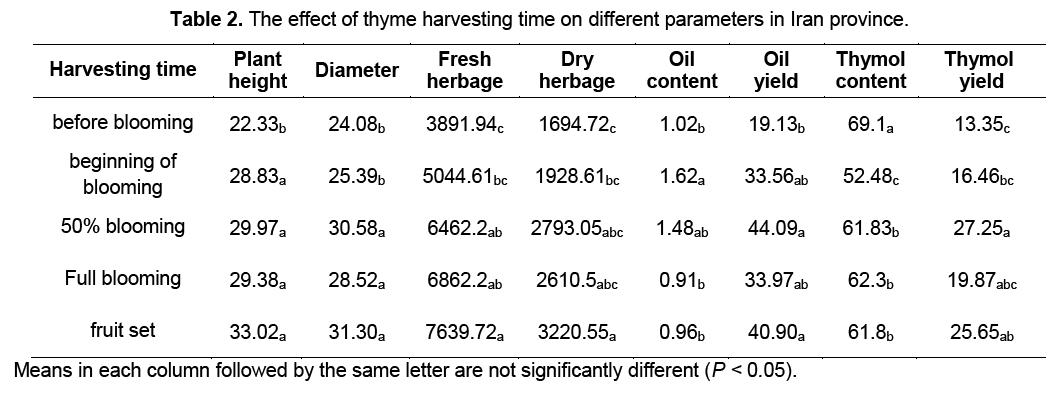
According to Figure 1, comparison of interaction effects harvest time on plant height revealed that the highest plant height T. daenensis (31.83 cm) and T. vulgaris (34.2 cm) were obtained at the stage of fruit set.
Results of mean comparisons, diameter revealed that the highest diameter (31.30 cm) was obtained at the stage of fruit set (Table 2).
According to Figure 2, comparison of interaction effects harvest time on diameter revealed that the highest diameter T. daenensis (38.5 cm) was obtained at the stage of fruit set and the highest diameter T. vulgaris (25.3 cm) was obtained at the stage of 50% blooming.
According to (Table 3) showed that the highest plant height (29 cm) was obtained at the T. vulgaris and the highest diameter (33.5 cm) was obtained at the T. daenensis.

3.2 Fresh and dry herbage
Statistical analysis (Table 1) indicated that different stages of plant growth had significant effect on dry herbage. Results of mean comparisons, fresh herbage revealed that the highest fresh herbage (7639.72 kg) was obtained at the stage of fruit set (Table 2).
According to Figure 3, comparison of interaction effects harvest time on fresh herbage revealed that the highest fresh herbage T. daenensis (10621.6 kg) was obtained at the stage of fruit set and the highest fresh herbage T. vulgaris (4964.4 kg) was obtained at the stage of 50% blooming.
Results of mean comparisons, dry herbage revealed that the highest dry herbage (3220.55 kg) was obtained at the stage of fruit set (Table 2).
According to Figure 4, comparison of interaction effects harvest time on dry herbage revealed that the highest dry herbage T. daenensis (4243.3 kg) was obtained at the stage of fruit set and the highest dry herbage T. vulgaris (3021.6 kg) was obtained at the stage of 50% blooming.
According to (Table 3) showed that the highest fresh herbage (8067 kg) and the highest dry herbage was obtained at the T. daenensis.
3.3 Content and oil yield
Statistical analysis (Table 1) indicated that different stages of plant growth had significant effect on oil yield. Results of mean comparisons, oil content revealed that the highest oil content (1.62 %) was obtained at the stage of beginning of blooming (Table 2).
According to Figure 5, comparison of interaction effects harvest time on oil content revealed that the highest oil content T. daenensis (1.41 %) was obtained at the stage of 50% blooming and the highest oil content T. vulgaris (2.42 %) was obtained at the stage of beginning of blooming.
Results of mean comparisons, oil yield revealed that the highest oil yield (44.09 kg) was obtained at the stage of 50% blooming (Table 2). According to Figure 6, comparison of interaction effects harvest time on oil yield revealed that the highest oil yield T. daenensis (46.7 kg) was obtained at the stage of fruit set and the highest oil yield T. vulgaris (43.36 kg) was obtained at the stage of 50% blooming.
According to (Table 3) showed that the highest oil content (1.28 %) was obtained at the T. vulgaris and the highest oil yield (36.92 kg) was obtained at the T. daenensis.
3.4 Content and thymol yield
Statistical analysis (Table 1) indicated that different stages of plant growth had significant effect on thymol content and thymol yield. Analysis and identification of components showed thymol main compounds in all samples. Results of mean comparisons, thymol content revealed that the highest thymol content (69.1%) was obtained at the stage of before blooming (Table 2).
According to Figure 7, comparison of interaction effects harvest time on thymol content revealed that the highest thymol content T. daenensis (84.1 %) was obtained at the stage of before blooming and the highest thymol content T. vulgaris (74.8 %) was obtained at the stage of beginning of blooming.
Results of mean comparisons, oil yield revealed that the highest thymol yield (27.25 kg) was obtained at the stage of 50% blooming (Table 2).
According to Figure 8, comparison of interaction effects harvest time on thymol yield revealed that the highest thymol yield T. daenensis (31.62 kg) was obtained at the stage of fruit set and the highest thymol yield T. vulgaris (24.24 kg) was obtained at the stage of 50% blooming.
According to (Table 3) showed that the highest thymol content (68.7 %) and the highest thymol yield (24.4 kg) was obtained at the T. daenensis.
4. Discussions and Conclusion
Results of mean comparisons revealed that the highest fresh herbage (7639.72 kg) and the highest dry herbage (3220.55 kg) were obtained at the stage of fruit set (Table 2). Studies reported by Naghdibadi et al [17] indicated that the maximum yield of dry and fresh herbage, yield and content of oil and thymol yield (Thymus vulgaris L.) were obtained in beginning of blooming stage, as well as Ozguven and Tansi [18] showed that various harvesting times have significant effect on dry biomass weight and the highest dry matter was obtained stage of fruit set.
The highest oil content (1.62 % v/w) was obtained at the stage of beginning of blooming and the highest thymol content (69.1%) was obtained at the stage of before blooming (Table 2).
Result of Sefidkon and Rahimibidgoli [19] about Thymus kotschyanus Boiss showed that full flowering was the best time to gain the highest essential oil amount. Nejad-Ebrahimi et al [13] in their study on Thymus caramanicus Jalass observed that the lowest essence was obtained in vegetative phase (before flowering). They were reported that the yields of T. caramanicus oils (w/w) obtained from at different stages were 2.5, 2.1, 2.0, and 1.9% at flowering, floral budding, seed set and vegetative stages, respectively. Result of Jamali et al [20] about (Thymus maroccanus Ball) in Moroccan showed that the yield of essential oils based on dry weight at different stages were; vegetative (2.14%), flowering (leaves: 1.80%; flowers: 3.46%), and post-flowering (leaves: 0.98%; post-flowers: 2.46%).
Essential oil biogenesis has also been linked to the levels of primary metabolites Unsuitable. Environmental conditions may limit photosynthesis in plants and alter nutrient uptake and carbon, sugar, amino acid and inorganic ion fluxes [21].
The accumulation of the essential oil takes place in gland hairs, which are distributed on the surface of the epidermis of the aerial parts of the plant. The content of the essential oil can depend on origin, climate, harvest, as well as drying and storage conditions [14,22].
Comparison of interaction effects harvest time on oil content revealed that the highest oil content T. daenensis (1.41 %) was obtained at the stage of 50% blooming and the highest oil content T. vulgaris (2.42 %) was obtained at the stage of beginning of blooming (Figure 5). The highest thymol content T. daenensis (84.1 %) was obtained at the stage of before blooming and the highest thymol content T. vulgaris (74.8 %) was obtained at the stage of beginning of blooming (Figure 7).
Our results showed that T. vulgaris is rich in essential oil but T. daenensis rich in thymol.
Safaei et al [11] indicted that in T. daenensis of different harvesting stages in Isfahan, the highest amount of thymol was obtained from beginning of flowering stage (85.9%) and the highest amount carvacrol at fruit set. The maximum amount of P-cymene, 1,8-cineole and γ-terpinene were recorded at 50% flowering stage (3.4, 1.4 and 1.8% respectively). Studies carried out by Hudaib et al [23] about evaluation of thyme (T. vulgaris) oil composition and variations during the vegetative cycle showed that the oil collected in May/June (phenological stage of FB–FR) was characterized by significantly lower levels of monoterpene hydrocarbons mainly α-terpinene and the highest levels of oxygenated monoterpenes linalool and borneol, monoterpene phenols (mainly thymol) and their derivates (mainly, carvacrol methyl ether), sesquiterpenes (mainly β - caryophyllene) and their oxygenated derivates (caryophyllene oxide) in comparison with all other samples. Ghasemi Pirbalouti et al [7] reported the T. daenensis cultivated in Saman region produced highest thymol (70.3%), whereas those cultivated in Shahrekord region produced highest oil yield (1.16%, v/w) and T. daenensis wild growing produced highest carvacrol (24.8%). The results indicated that essential oils and their chemical compositions of Thymus species are strongly affected by environmental conditions and agronomic management practices. Researches on T. vulgaris conducted by Naghdibadi et al [17] showed that the highest thymol amount (47.99%) and thymol yield (55.28 kg/ha) were related to flowering initiation.
Jordan et al [12] in research of various harvesting times effects on oil quality and quantity of Himalayan thyme (Thymus hyemalis) observed that the highest density of gamma-terpinene (starter of p-cymene synthesis) was related to full flowering but the highest densities of thymol and carvacrol were obtained from full flowering and start of fruit ripening. Sefidkon et al [10] observed that thymol amount was increased gradually in T. vulgaris from the first of vegetative phase to full flowering. Results of a study by Nejad-Ebrahimi et al [13] indicted that the essential oils of T. caramanicus collected from Baft, Kerman province the highest content of carvacrol as major component (68.9%) was observed at full flowering stage, and the lowest content of carvacrol was observed at vegetative stage. They also were suggested at vegetative and seed set stages the amount of phenolic (carvacrol + thymol) portion was decreased, but the amount of their precursors (p-cymene + γ-terpinene) increased.
Interaction effect of year and different harvesting stages in (Thymus daenensis Celak) showed that the highest aerial dry weight and essential oil yield (3083 and 68.61 kg/ha respectively) were recorded at full flowering stage in the second year. In both years, the highest amount of essential oil percentage was observed at 50% flowering [11].
There are some minor differences in the relative amounts of other components in different satges of plant growth. Studies reported by McGimpsey et al [14] indicated that the highest oil and phenol contents resulted in plants harvested after full blooming stage. This variation may be referred to the seasonal variations that affected chemical component yields and contents in (Thymus vulgaris L.). Ghasemi Pirbalouti et al [24] reported that the altitude showed be considered as a major factor influencing the chemical of (Thumys daenensis Celak) altitude seems affecting essential oil content of only oil rich and oil-intermediate aromatic plants. Changes regime of thymol percentage showed that this plant had highest thymol in vegetative phase but with passing vegetative phase and entrance to flowering phase, an obvious reduction in thymol amount occured, then in full flowering, thymol amount on the decrease that its reason could be various environmental and genetic factors. The results Semnani et al [25] showed that the highest oil yield of Thumys pubescens obtained at full flowering stage. The variability of thymol and carvacrol contentsin the essential oils that obtained from T. daenensis cultivated and wild growing can be attributed mainly to environmental conditions as well as agronomic management including irrigation, plant density and soil tillage [26]. Controlled growth systems also make it feasible to contemplate manipulation of phenotypic variation in the concentration of medicinally important compounds present at harvest [27]. Shortage of water in arid and semi-arid parts of this region where annual precipitation is less than 300 mm with almost no rainfall during the summer is a prominent limiting factor of Thymus production. Good management and adoption of suitable practices will improve economic Thymus production [28].
According to the results of this project at the stage fruit set for T. daenensis and at the stage 50% blooming for T. vulgaris optimum of harvest time on the quantity/quality of essential oil and thymol yield in Isfahan province. Agricultural factors have a critical effect on quantitative and qualitative characteristics of thyme, which finally result in plant growth and yield increment. Harvesting schedule can be very effective factors in this area. Therefore farmers in semiarid regions should grow cultivated species for producing highest economic amount of extracted essential oil and thymol for pharmaceutical, therapeutic and food purposes.
Acknowledgements
This research project has been supported by Islamic Azad University, Isfahan (Khorasgan) branch, Isfahan, Iran. This support is highly appreciated.
References
- Mozaffarian V. (2008). A Pictorial Dictionary of Botany Botanical Taxonomy Latin–English–French–Germany –Persian/Complied. Farahang Moaser,Tehran, 522.
- Cronquist A. (1988). The Evolution and Classification of Flowering Plants. The New York Botanical Garden, New York, USA.
- Rechinger K.H. (1963–1998). Flora Iranica, Akademische Druck und Ver-lagsanstalt, Graz, Austria, 1–173.
- Blanco E., Morales R., Pellin R. (1998). Harvesting and trade of Thymus in Spain. Medicinal plant trade in Europe: conservation and supply. In: Proceedings of the First International Symposium on the Conservation of Medicinal Plants in Trade in Europe, Brussel, Belgium, 50–54.
- Stahl-Biskup E. (2002). In Thyme: The genus thymus. Essential oil chemistry of the genus thymus—A global view. Taylor and Francis: London, 75–124.
- Zargari A. (1989). Iranian medicinal plants. Tehran. University Publication, (in Persian).
- Ghasemi Pirbalouti A., Hashemi M. et al. (2013). Essential oil and chemical compositions of wild and cultivated Thymus daenensis Celak and Thymus vulgaris L. Ind Crops Prod, 48: 43– 48.
- Masada Y. (1976). Analysis of essential Oils by gas Chromatography and Mass Spectrometry, 7; 301-309.
- Omidbaigi R., Fattahi F., Karimzadeh G.h. (2010). Harvest time effect on the herb yield and essential oil content of lemon thyme (Thymus × citriodorus (Pers.) Schreb). Iranian J Med Aroma Plants, 26: 318- 325.
- Sefidkon F., Nikkhah F., Sharifi Ashoorabadi E. (2009). The effect of distillation methods and plant growth stages on the essential oil content and composition of Thymus vulgaris L. Iranian J Med Aroma Plants, 25: 309 – 320.
- Safaei L., Sharifi ashoorabadi E., Zeinali H., Mirza M. (2012). The effect of different harvesting stages on aerial parts yield, essential oil percentage and main components of Thymus daenensis Celak. Iranian J Med Aroma Plants, 28: 342-355.
- Jordan M.J., Martınez R.M. et al. (2006). Seasonal variation of thymus hyemalis Lange and Spanish Thymus vulgaris L. essential oils composition. Ind Crops Prod, 24: 253–263.
- Nejad Ebrahimi S., Hadian J. et al. (2008). Essential oil composition and antibacterial activity of Thymus caramanicus at different phenologycal stages. Food Chem, 110: 927-931.
- McGimpsey J.A., Douglas M.H. et al. (1994). Seasonal variation in essential oil yield and composition from naturalized Thymus vulgais L. in New Zealand. Flavour Fragrance, 9: 347–352.
- Rey C. (1991). The effect of date and height of cut in the first year on the yield of sage and thyme. Revue Suisse de Viticulture, d Arboriculture etd Horticulture, 23: 137–143.
- Thompson J.D., Chalchat J.C. et al. (2003). Qualitative and quantitative variation in monoterpene co-occurrence and composition in the essential oil of Thymus vulgaris chemotypes. J Chem Ecol, 29: 858-880.
- Naghdibadi H., Yazdani D., Sajed M.A., Nazari F. (2004). Effects of spacing and harvesting time on herbage yield and quality/quantity of oil in thyme, Thymus vulgaris L. Ind Crops Prod, 19: 231–236.
- Ozguven M., Tansi S. (1998). Drug yield and essential oil of Thymus vulgaris L. as in influenced by ecological and ontogenetical variation cukurova university, Tr. J. Agric. Forestry, 22: 537-542.
- Sefidkon F., Rahimi Bidgoli A. (2002). Assessment of quantitative and qualitative variation of essence in Thymus kotschyanus in plant growth period and different distillation methods. Iranian J Med Aroma Plants, 15: 1-22.
- Jamali C.A, Kasrati A. et al. (2013). Phenological changes to the chemical composition and biologicalactivity of the essential oil from Moroccan endemic thyme (Thymus maroccanus Ball). Ind Crops Prod, 49: 366-372.
- Srivastava N.K., Luthra R. (1991). Distribution of photosynthetically fixed 14CO2 into essential oil in relation to primary metabolites in developing peppermint (Mentha piperita) leaves. Plant Sci, 76: 153–157.
- Venskutonis P.R. (1997). Effect of drying on the volatile constituents of thyme (Thymus vulgaris L.) and sage (Salvia officinalis L.). Food Chem, 59: 219–227.
- Hudaib M., Speroni E. et al. (2002). GC/MS evaluation of thyme (Thymus vulgaris L.) oil composition and variations during the vegetative cycle. Journal Pharm Biom Ann, 29: 691–700.
- Ghasemi Pirbalouti A., Rahimmalek M. et al. (2011). Variation in antibacterial activity, thymol and carvacrol contents of wild populations of Thymus daenensis subsp. daenensis Celak. Plant Omics, 4: 209–214.
- Semnani M.K, Rostm B., Akbarzadeh M. (2006). Essential oil composition of thymus kotschyanus and thymus pubescens from Iran. Journal Essent. Oil Res, 18: 272-274.
- Lubbe A., Verpoorte R. (2011). Cultivation of medicinal and aromatic plants forspecialty industrial materials. Ind Crops Prod, 34: 785–801.
- Canter P.H., Thomas H., Ernst E. (2005). Bringing medicinal plants into cultivation: opportunities and challenges for biotechnology. Trends Biotechnol, 23: 180–185.
- Wang C.R., Tian X.H. (2004). Effects of plastic sheet-mulching on ridge for rainwater harvesting cultivation on WUE and yield of winter wheat. Sci. Agric. Sin, 37: 208- 214..

Open Access Journals
- Aquaculture & Veterinary Science
- Chemistry & Chemical Sciences
- Clinical Sciences
- Engineering
- General Science
- Genetics & Molecular Biology
- Health Care & Nursing
- Immunology & Microbiology
- Materials Science
- Mathematics & Physics
- Medical Sciences
- Neurology & Psychiatry
- Oncology & Cancer Science
- Pharmaceutical Sciences
